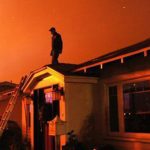
‘Out of control’ Southern California fire explodes overnight, forcing thousands to flee
VENTURA, Calif. — Ferocious fires tore through Southern California on Tuesday, burning massive stretches of land in a matter of hours and forcing tens of thousands of people from their homes.
Firefighters in multiple locations in the region battled fires that were spurred by dry and windy conditions, officials said. In Ventura County, the Thomas Fire burned more than 50,000 acres, and on the outskirts of Los Angeles County, the Creek Fire enveloped more than 11,000 acres north of the city’s downtown. Another fire in the county, dubbed the Rye Fire, had cut through 5,000 acres near the city of Santa Clarita by Tuesday evening.
Authorities issued ominous warnings of more dangers to come during a “multiday event” across the area, as weather forecasters said the region faces “extreme fire danger” through at least Thursday because of intense Santa Ana winds and low humidity that could cause the fires to grow rapidly.
The wildfires are the latest grim chapter in a brutal year for California, coming just months after deadly blazes in the state’s wine country killed dozens of people and razed thousands of buildings. Many parts of the state experienced record temperatures over the summer and in the fall; a sweltering heat wave brought cities in the Los Angeles area above 100 degrees as recently as late October.
The Ventura County fire, the largest, began when a small blaze quickly went out of control. The fire — which burned an area nearly as large as Seattle — stretched into the city of Ventura, home to more than 100,000 people, its course sped by high winds that ranged from 35 to 55 miles per hour. More than 150 buildings were damaged or destroyed in the fire, and officials said they anticipated many more.
“The prospects for containment are not good,” Ventura County Fire Chief Mark Lorenzen said at a news briefing. “Really, Mother Nature’s going to decide when we have the ability to put it out.”
As the flames continued to spread, so did the damage. Homes were destroyed and the charred remains of cars sat among heaps of ash. Aerial images showed huge clouds of thick smoke billowing around the Los Angeles region.
The impact hit home for many of those responding to the blaze: One local fire official told a reporter that he had to call his daughter to tell her that her apartment had burned.
California Gov. Jerry Brown (D) declared a state of emergency in Ventura County, calling the fire “very dangerous” as it spread rapidly: “We’ll continue to attack it with all we’ve got,” Brown said. “It’s critical residents stay ready and evacuate immediately if told to do so.”
What caused the fire remained unknown Tuesday, Lorenzen said, and the fire’s ultimate impact also remained unclear. Lorenzen said that the number of burned buildings could increase because firefighters were not yet able to assess the damage in most affected areas. He also warned that there is “a high possibility” that more areas will be evacuated.
Lorenzen said 27,000 people were evacuated, and “almost none of them know the status of their homes.”
Some of those who did were given bad news. Debbie Gennaro, who wiped tears from her eyes as she was consoled by her husband, Mark, said they were told that their home of 12 years has been burned to an ashy husk.
They had packed up clothes, photographs and passports on Monday night and headed to a hotel ahead of the fire; the couple are unsure where they will go next.
“This is life in Southern California. This is where we live,” Mark Gennaro said. “I stand on that back hill and I see all that brush and I’m like, ‘Something’s gonna happen at some point.’”
The fires Tuesday sparked unusually late in the wildfire season, which typically runs from spring to late fall. That is because, unlike other parts of the United States, summer and early fall tend to be dry in California. Wildfires need just three things to start and spread: fuel, dry weather and an ignition source.
The dry weather is significant this week — humidity was just 10 percent on Monday morning and “red flag” fire conditions will last through at least Friday, according to the National Weather Service.
The fire’s fuel was a year in the making. After an epic, multiyear drought, California finally got the rain and snow it needed last winter, and it allowed vegetation to rebound. The hills turned green and the brush thickened. But as the weather turned dry, it created plentiful amounts of fuel, which are now feeding the wildfires.
Cal Fire official Tim Chavez said that a lack of rain in the region in recent months made conditions particularly susceptible to a wildfire.
“This year however no rain came in September, October and November in Southern California. So we have incredibly desiccated dry fuels,” he said.
Though the Santa Ana winds are not unusual, “that combined with the dry fuels results in what you see today,” Chavez said.
People who escaped the fires reported apocalyptic scenes.
Gena Aguayo, 53, of Ventura, said she saw fire “coming down the mountain.” When Lorena Lara evacuated with her children on Tuesday morning after initially staying put, she said the wind was so strong it was blowing ashes into her home.
“I’ve never experienced something like that,” said Lara, 42. “Maybe in Santa Barbara, but we didn’t expect it here.”
As the fires forced waves of people to rush from their homes, the contours of daily life were shut down. Multiple schools were closed Tuesday, while some events were canceled amid the fires and power outages. In Santa Barbara and Ventura counties, more than 260,000 people were left without power at some point, Southern California Edison said in a tweet. Officials in the city of Ventura urged residents to boil water because of the fires and power outages.
Fire officials were blunt about the blaze, saying that it was out of control and that structures throughout the area were under serious threat, with Ventura County officials saying that “due to the intensity of the fire, crews are having trouble making access and there are multiple reports of structures on fire.”
Further east, firefighters also hurried to respond to the Creek Fire north of downtown Los Angeles that also expanded quickly, growing to 11,000 acres by early Tuesday afternoon. Officials said that fire began outside the city limits before threatening parts of the Sylmar and Lake View Terrace areas.
Los Angeles Mayor Eric Garcetti declared a state of emergency in the city and said that more than 30 buildings had burned in the blaze. He said that some 150,000 people lived in evacuation areas.
“We want to be really clear, folks,” he said. “We have lost structures, we have not lost lives. Do not wait. Leave your homes.”
Los Angeles County Fire Chief Daryl L. Osby said that “when we’ve had fatalities, it’s because people did not heed the early-warning evacuations.”
“This is going to be a multiday event,” Los Angeles Police Chief Charlie Beck warned. “This will not be the only fire.”
[Santa Ana winds sparked a critical wildfire threat in Southern California]
Osby said the county department diverted two helicopters to respond to the Rye Fire near Santa Clarita, where officials said the blaze had shut down the interstate.
The Creek Fire prompted a wave of mandatory evacuations, forcing people to leave about 5,000 homes. A convalescent hospital evacuated 105 patients, officials said.
It was unclear how many people have been injured or killed in the fires. In Ventura County, a battalion chief was injured in a traffic accident on Monday night and is expected to recover, Lorenzen said. Two firefighters were receiving treatment after being injured in the other fires, Garcetti said. And three peoplewere injured in a much smaller blaze earlier in the day in San Bernardino County, according to local news reports.
The National Weather Service reported that damaging winds and “very critical fire weather conditions” would return late Wednesday night into Thursday, saying the conditions could lead to “very rapid fire growth” and “extreme fire behavior.” The NWS issued a red flag warning for Ventura and Los Angeles, saying wind gusts between 50 mph and 70 mph are likely through Thursday.




